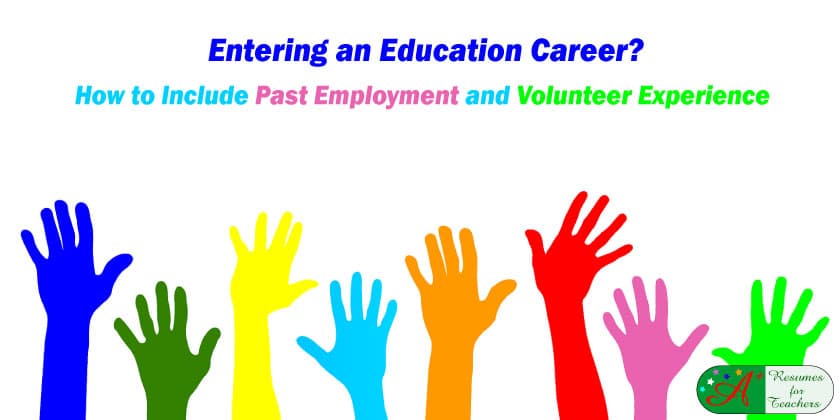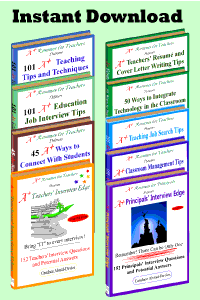Are you wondering how to include past employment history or community services in your resume when transitioning to teaching?
As someone entering the field of education, you may not have much experience that directly relates to the classroom. The key is to include every position related to instruction, group leadership, training, plan development and implementation, etc.
Highlight Your Transferable Skills
Demonstrate your past positions and job responsibilities similar to those a teacher requires. This will show potential schools you have the experience and skills they seek.
Pick out the relatable positions mentioned above when determining whether you should include every job you have ever had or just particular ones. Knowing what to include and omit from your resume will affect the number of interviews you generate.
These may include corporate trainers, daycare workers, coaches, etc. Even if your primary duties are separate from teaching, you may find one or two tasks that you regularly perform that correspond with your new desired career.
For example, perhaps it is your responsibility to develop, edit, and administer training materials to new employees in your plant. This responsibility can be seen as similar to writing and helping with lesson plans in the classroom. Make sure that you include this job and highlight this task.
Include Every Teaching Related Experience
Even if you have minimal hands-on classroom experience, include all of it in your resume. If you have 40 hours of classroom observation time, then mention it.
List it as a regular job in your resume, including the school you were at, its location, the dates you worked, and the classroom you were in. Briefly describe what you did while you were there. For example, watching how the regular classroom teacher handled behavioral problems, delivered lectures, and utilized various methods to engage them.
Mention if you provided one-on-one support to the students, presented units to the class, effectively handled any problems, and anything else you may have gained from experience.
When listing your work experience, include anything that involved you being in the classroom or helping students. Put all these positions under a header of Teaching Experience. For the rest of your past posts, go chronologically from newest to oldest. Highlight relevant job responsibilities as well as essential duties.
Leave Off Non-Pertinent and Older Experiences
If you enter the world of education at a more mature age, you do not have to list every job. Include positions from about ten years past, ensuring that everything relevant is mentioned, even from 10+ years ago. Some people will include older experiences in an autobiography if they happen to create one.
On the other hand, if you have not been in the workforce for long but have held many positions, it is a good idea not to include all of them. Don’t look like a job hopper who cannot commit and make up their mind.
Again, include everything relevant to teaching and student support. Filter out positions you held for less than six months or are entirely irrelevant. For instance, your pizza delivery job during the summer of 2017 won’t be needed.
Use Volunteer Experience and Community Activities
Volunteering is not only a reward in itself, but it can also be added to your resume. Participating in community activities shows potential employers that you are committed, hardworking, and an active team player within the local population.
Highlighting your relevant volunteer experience is an excellent way to demonstrate applicable skills and hands-on experience as a career changer. This is especially true if you have minimal formal training or time in the classroom.
If you are not already involved as a volunteer in your local community, you should be. Depending on your chosen program, you may work many hours a week or only a few per month.
What Volunteer Experiences Should You Include?
You may want to acquire education- or student-related positions, such as tutor, coach, camp counselor, classroom aide/assistant, or Sunday school teacher. Reading to children at the library or helping with an after-school program is a great way to become involved in education outside of a formal or traditional setting.
When incorporating your volunteer experience and community activities into your resume, determine which positions involved you in a classroom or instructing children. Any posts that fall into that category can be put in a separate section. Entitle the section ‘Classroom Experience’ or ‘Instructional Experience.’
If you already have paid experience in a school setting, it is good to put volunteer activities immediately following your formal time in the classroom. This would include any practicum or student teaching experiences. The new section header will read Additional Classroom (or Instructional) Experience.
List each position like you would with your other jobs. Include the school name, location, dates worked, and title held. Explain your role, responsibilities, and accomplishments. You might think these positions should only count if you are paid; however, that is not the case.
What you include in the resume must show the value you can bring to the school district.
School administrators are not concerned about your past wage; they want to see that you have had the experience and developed the skills and qualities essential for being a well-rounded teacher.
As for everything else, insert other volunteer experience at the end of your resume under the header of Volunteer Experience or Community Involvement.
Add anything relevant you currently participate in, from tutoring to helping at the soup kitchen. Include positions you have held over the past five years. List your job title, the organization’s name, and the dates you were active.
Mention Volunteer Work in Your Cover Letter
Your level of involvement and how relevant your role was to be a classroom teacher, mention your volunteer experience in your cover letter, again reinforcing your commitment and hard work. Remember to discuss your community involvement when it comes time for the interview.
Remember, when changing your career to teaching, don’t overlook past positions and experiences that you may not think are directly teaching-related. Upon further inspection, many of your past experiences can include critical teaching-related skills and accomplishments that schools will find desirable.
When creating your career change resume and cover letter, describe your past experiences through a teaching-focused lens. This will ensure you correctly highlight the transferable skills and accomplishments schools seek.
Do you need help creating a solid resume and cover letter for your new teaching career? Contact Candace today via email, call 1 877 738 8052, or view our services.


